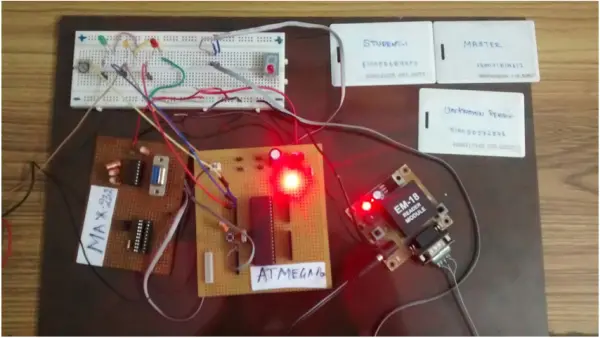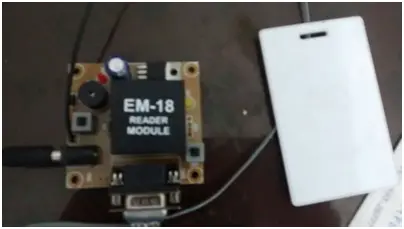RFID technology has significantly revolutionized our lives by streamlining machine communication. Its widespread use spans across various sectors such as schools, hospitals, industries, and more. This article provides guidance on constructing a straightforward yet dependable RFID-based security system utilizing an AVR microcontroller, a solution that proves both reliable and cost-effective. Prior familiarity with RFID principles and interfacing is essential. Therefore, it’s recommended to review the “How to interface RFID with AVR Microcontroller” tutorial before embarking on this project.
DESIGN OF RFID BASED SECURITY SYSTEM:
The setup involves an RFID reader module and RFID tags that utilize UART serial communication for interaction. When an RFID tag enters its range, the RFID module detects and captures the tag’s 12-bit ID. This unique identification code is then transmitted to the Microcontroller through the UART protocol for subsequent processing. Since the module functions within the RS232 logic range of +25V to -25V, an IC MAX232 level converter is necessary to convert the data to TTL logic, suitable for Microcontrollers.
To activate the doors, three relays should be linked to PORTB. For simplicity in the schematic design, only one relay was depicted above. If the RFID reader provides data in TTL logic, the use of MAX232 for conversion can be disregarded.
SCENARIO:
In this project, a school-level security scenario was selected to illustrate the system’s functionality. Each tag corresponds to a specific security level. For instance, a professor (identified by the “MASTER TAG”) possesses access to all school rooms and floors, while a student (identified by the “STUDENT TAG”) is granted access solely to classrooms. Guests, identified by the “GUEST TAG,” are restricted to accessing only the lobby area. Three relays from PORTB serve as door activators for these designated areas.
I possess three RFID tags: “MASTER,” “STUDENT,” and “GUEST.” When the RFID reader detects the “MASTER TAG,” all three relays are activated, allowing the professor unrestricted access to all rooms. In the case of the “STUDENT TAG,” only the relay connected to the classroom door is activated, granting access exclusively to that area. Lastly, when the RFID reader recognizes the “GUEST TAG,” only the relay controlling the lobby door activates, restricting access solely to the lobby area.
ALGORITHM:
1. Set up UART communication within the controller.
2. Begin scanning for tags using the RFID reader.
3. Sequentially read the 12-byte RFID ID via UART upon tag detection.
4. Compare the ID with stored records and retrieve the security level associated with the identified ID.
5. Trigger the relay or open the door based on the assessed security level.
6. Pause for five seconds and deactivate the relay to prevent unauthorized access (tailgating).
COMPONENTS USED:
1. Microcontroller AVR Atmega32
2. Module for RFID reading
3. RFID TAG
4. Module for LCD display
5. Circuit MAX232
6. Interconnecting wires (Jumper wires)
CODE:
- #include<avr/io.h>
- #include
- #include
- voidusartinit();
- //unsigned char a;
- unsignedcharvalue[15];
- unsignedint b;
- unsignedint k=0,i=0,j,l;
- unsignedchar value1[]={“140071D1A612”}; //Predefined ID
- unsignedchar value2[]={“51005D6899FD”};
- intmain ()
- {
- DDRC=0xFF;
- DDRB=0xFF;
- PORTB=0x00;
- usartinit();
- while(1)
- {
- while((UCSRA)&(1<<RXC))
- {
- value[i]=UDR;
- _delay_ms(1);
- i++;
- if(i==12)
- {
- value[i]=”;
- for(j=0;value1[j]!=”;j++)
- {
- if(value[j]==value1[j])
- k++;
- }
- if(k==12) //Match with the predefined ID
- {
- PORTB|=(1<<0)|(1<<1)|(1<<2); //Master have access to all rooms
- _delay_ms(5000);
- PORTB=0x00;
- }
- else
- {
- k=0;
- for(j=0;value2[j]!=”;j++)
- {
- if(value[j]==value2[j])
- k++;
- }
- if(k==12)
- {
- PORTB|=(1<<1); //Student have access to class rooms only
- _delay_ms(5000);
- PORTB=0x00;
- }
- else
- {
- PORTB|=(1<<2); //Guest have access to lobby only
- _delay_ms(5000);
- PORTB=0x00;
- } } } } } }
- voidusartinit()
- {
- UBRRH=00;
- UBRRL=77;
- UCSRB|=(1<<RXEN);
- UCSRC|=(1<<URSEL)|(1<<UCSZ0)|(1<<UCSZ1);
- }


